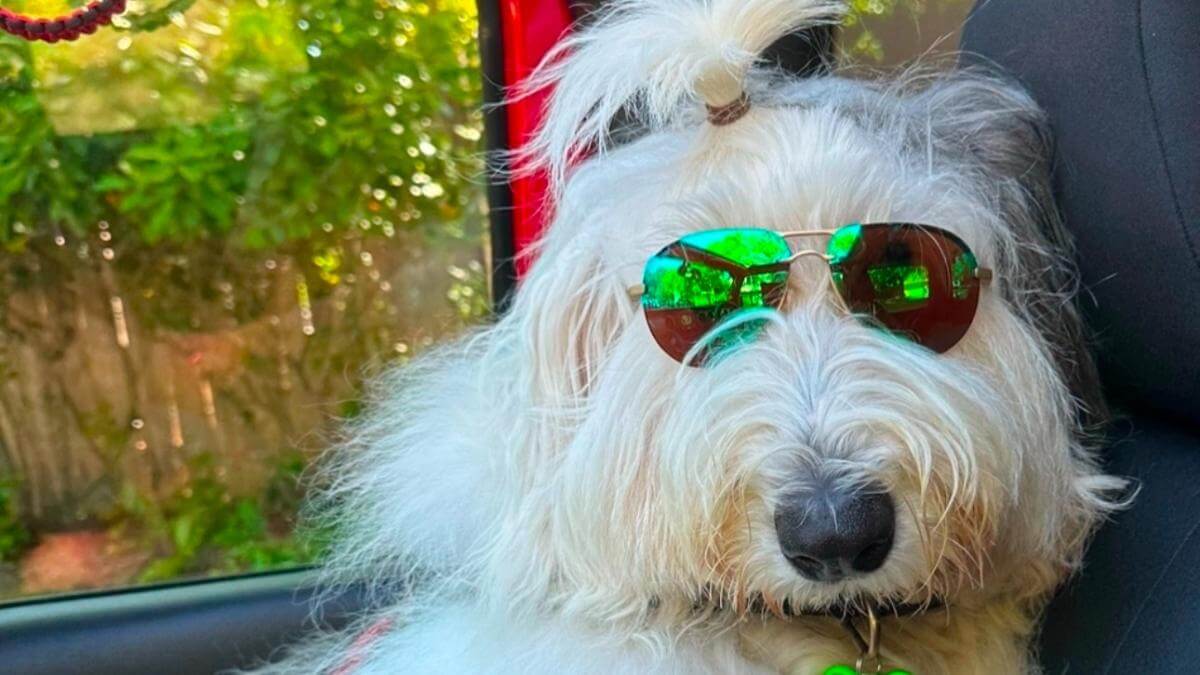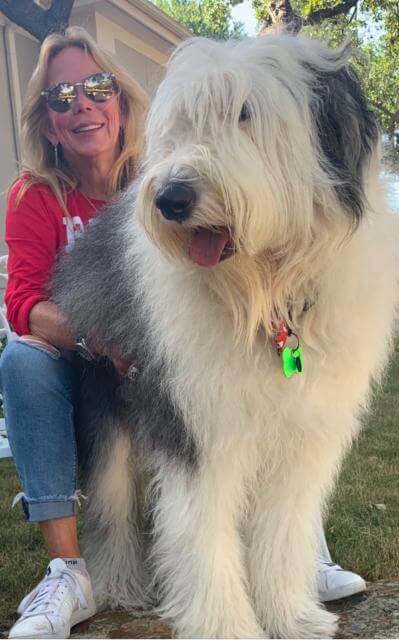


Home » AKC Humane Fund ACE Award Winner – Therapy Dog: Wallace

Allison LaField: Wallace is my personal Service Dog who goes to work with me every day. At work I am a swim coach. I have an adult United States Masters Swimming swimmer, Col. Heather Yun, who (at the time, 2020) was a physician at Brooke Army Medical Center. She was aware BAMC was starting up a Therapy Dog program, and she very much wanted to see Wallace in this program and encouraged me to look into therapy work. Col. Yun is a big fan and personal friend of Wallace’s. Her encouragement to explore therapy work is what opened the door to discover more of Wallace’s hidden talents doing therapy work. She has since retired from BAMC and now runs the Veterans Administration Hospital in San Antonio, where Wallace is proudly working as a Therapy Dog for the VA.
Allison LaField: To become an AKC Therapy Dog, the dog must be certified or registered by an AKC recognized therapy organization. Wallace and I belong to Alliance of Therapy Dogs. You also have to have an AKC or PAL registration number, which Wallace possesses. Then you begin your visits and earn various AKC Therapy Dog designations. Earning a Novice designation takes 10 therapy visits. Different titles require a different number of visits. Wallace has earned the DISTINGUSHED designation, awarded through the AKC. He has completed enough hours to be considered for the Therapy Dog Supreme, but I have not completed his paperwork for this as of yet.
Allison LaField: I would caution anyone who wants to own a sheepdog to really research the breed, to visit with AKC reputable breeders and owners of OES to fully understand the time commitment required for owning this breed. They are a lot of work! I know, I have two and am temporarily fostering a third who was displaced by a house fire. But if you know what you are in for it can be very enjoyable and rewarding.
Old English Sheepdogs are a very unique breed. They have many traits that make for a great Therapy Dog. They are friendly and love being around people – often referred to as the “Velcro” dog. OES are cheerful extroverts and are popular family companion animals. They are known for being intelligent, affectionate, loving, watchful, faithful, loyal, and protective. They are very smart and easily trainable, yet can be stubborn at times and can get bored. They are good with children, people, and other pets. They are fearless, have strong protective instincts, and are excellent watchdogs. They are also known for their shaggy coats, bear-like gait, silly personalities and antics, and resonant “broken bell” sounding bark.
But just like people, all OES are not the same. Some will make wonderful Service Dogs and Therapy Dogs, but some may not, because they simply do not possess the desirable traits for service or therapy work. That does not take away from what wonderful animals they are, it just means they are cut out for a different type of work. They love having a job to do. This is a working breed—they are herders by nature. They protect the flock.
Allison LaField: Wallace and I have had many memorable moments. “He has an uncanny ability to read people better than many humans do” is a direct quote from Col. Yun. I believe Wallace and I have a very tight, close emotional bond, and this dog knows me better than I know myself. In return, I have learned to listen, trust, and read Wallace and his behavioral cues. He’s very predictable and methodical with his alerts. He has alerted to people in distress at the pool. He has alerted to potential drownings and medical issues experienced by pool patrons. He has alerted to medical conditions occurring even before the person experiencing the emergency realizes what is happening. Wallace is highly intuitive and quick to react when he senses something unusual. He’s also vocal when he senses an issue is about to occur. I have learned to listen to Wallace and have become very aware of the cues and signals Wallace gives me, as he lets me know what’s happening. It’s been about learning to trust your dog.

The most memorable moment with Wallace was not therapy-related but before he was therapy- or service-trained. He was still a puppy, maybe 7-9 months old. Just a regular old puppy doing puppy things. I never expected him to be anything more than the family dog. I reached down into my backyard swimming pool to untangle the self-cleaning Polaris cord, and as I pulled the Polaris out of the water to unknot it, I tripped. I fell, and have since been told I suffered my first episodic event (seizure). I hit my head on the pool coping and I fell into the water fully clothed. And after the fact, I found out I had broken my right hip and had a pretty bad head concussion.
I found myself on the bottom of the deep end, dazed and confused, and unable to find the way up to the surface of the water. (This was related to the head trauma I sustained.) I was running out of air, and all my CPR/AED/and lifeguard training and coaching safety skills were kicking in saying, “Don’t panic, don’t panic.”
Everything was moving in slow motion, and I was thinking the headline in the local newspaper was going to be: “Swim Coach Drowns in Her Own Backyard Pool.” As I was trying to find the way up to get air, and starting to worry that I couldn’t find the way up, Wallace jumped into the pool and came swimming across the surface of the water. Those giant paws were creating lots of air bubbles, and visually I could see he was on the surface of the water. He circled me until I was able to get to the top of the water from the deep end, and stayed by my side until he got me to the steps. He just stayed right beside me, never moving, never in a hurry, until I was ready to try to get out of the pool. Days later I realized the hidden talents, the highly intuitive perception skills this dog possessed. He instinctively knew I was in trouble, and this cute puppy dog Wallace nonchalantly jumped in like it was no big deal—and literally saved my life. And then, he just went about his day, as if it was no big deal.
Allison LaField: Our partnership has impacted my work because he is a fixture at the pool, and is usually the first to alert that we have a problem with a swimmer in the water or on the pool deck. Keep in mind, we have hired professional lifeguards and professional staff with eyes on deck at all times. But many times, it is Wallace who is the first to sense a potential issue.
As for our life at home together, we work as a well-oiled machine. We are truly a team. Wallace lets me know when I’m about to have a seizure so that I can take the necessary precautions. When we are out doing therapy work, he does the same thing; he’s constantly alerting or telling me, or picking up on cues of what’s happening before an actual event occurs. This dog has a remarkable talent for reading and picking up on cues from people for what they need or what is going on with them.
Wallace is truly an amazing dog and I am proud of his accomplishments and awards, but also so very happy for him to be recognized for being such a remarkably exceptional animal who has positively impacted not only my life but the lives of so many people he comes into contact with. I believe Wallace has superpowers. Everyone likes to say that he has achieved “rockstar” status, because when he enters the building, either at work or for therapy work, you can always hear people saying, “Wallace has entered the building!”